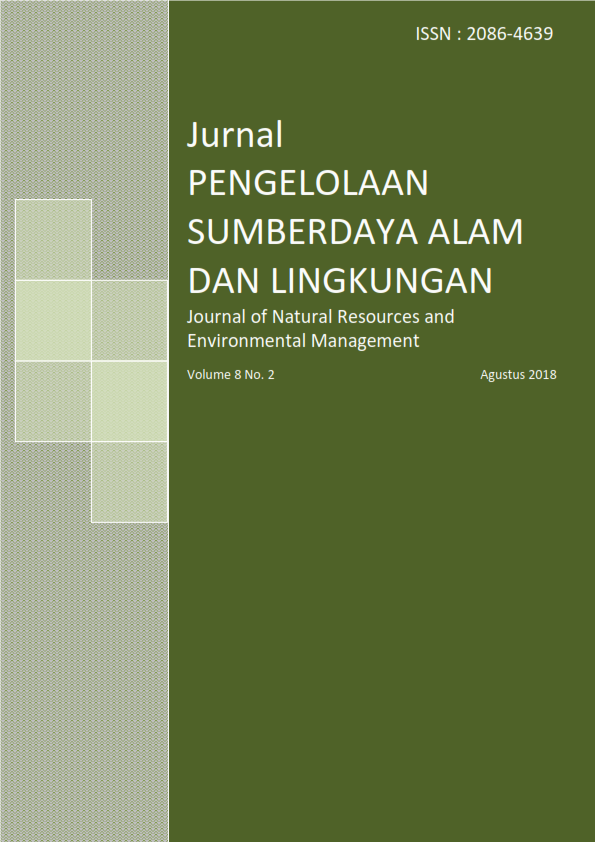PEMANFAATAN SERBUK GERGAJI SEBAGAI SUBSTITUSI BAHAN BAKAR PADA PROSES PEMBAKARAN - KILN DI PABRIK SEMEN DENGAN PENDEKATAN LIFE CYCLE ASSESMENT (LCA)
Abstract
References
[ASI] Asosiasi Semen Indonesia, 2014. Petunjuk Teknis Perhitungan dan Pelaporan Emisi CO2 Industri Semen. Kementerian Industri, Jakarta.
[CDM] Clean Development Mechanism, 2012. Indocement alternative fuels project, pp 48 [terhubung berkala].https://cdm.unfccc.int/filestorage/0/Y/0/0Y0MXUD1XLRMSVPW89U6M8P1MF1WIY/PDD_Indocement%20Alternative%20Fuel_2006-05-11.pdf?t=aXd8b3JiYTVrfDB6YC2qz0Q8obwHHrsPgAJV [20 Ferbruari 2017]
[ESDM] Kementrian Energi dan Sumberdaya Mineral, 2016. Faktor Emisi Gas Rumah Kaca Sistem Interkoneksi 2014. Dirjen Ketenagalistrikan, Jakarta.
[IPCC] Intergovermental Panel of Climate Change, 2012. Climate change 2007, the physical science basis. IPCC, pp. 4-5. [terhubung berkala].https://www.ipcc.ch/pdf/assessment-report/ar4/wg1/ar4-wg1-errata.pdf [8 Agustus 2017]
[Kemenperin] Kementrian Peridustrian, 2012b. Peraturan Menteri Perindustrian Nomor 12 Tahun 2012 tentang Peta Panduan (Road Map) Pengurangan Emisi CO2 Industri Semen Indonesia. Kemenperin, Jakarta.
[Kemenperin] Kementrian Perindustrian, 2012a. Draft Petunjuk Teknis Perhitungan Emisi Gas Rumah Kaca (GRK) di Sektor Industri. Badan Pengkajian Kebijakan Iklim dan Mutu Industri, Jakarta.
[KLH] Kementrian Lingkungan Hidup, 2012. Pedoman Penyelenggaraan Inventarisasi Gas Rumah Kaca Nasional, Volume 1 Metodologi Perhitungan Tingkat Emisi Gas Rumah Kaca Pengadaan dan Penggunaan Energi. KLH, Jakarta.
[KLH] Kementrian Lingkungan Hidup, 2014. Laporan Inventarisasi Gas Rumah Kaca Tahun 2014. KLH, Jakarta.
[Setkab RI] Sekretariat Kabinet Republik Indonesia, 2011. Peraturan Presiden Nomor 61 Tahun 2011 tentang Rencana Aksi Nasional Penurunan Emisi Gas Rumah Kaca. Setkab RI, Jakarta.
[WBCSD; IEA] World Busines Council for Sustainable Development, Internatioanl Energy Agency. 2009. Cement Technology Roadmap 2009, Carbon Emmisions Reduction Up to 2050. IEA Publications, Paris.
Armansyah F., H. Hilal, Ifanda, A. Hasan, M. Iksan, E.S. Hariatie, B. Ismoyo, S. Syafei, A.P. Mayasari, K.P. Ola, A. Suhendra, 2012. Benchmark Kualitas Daya Industri Semen. BPPT Press, Jakarta.
Baidya R., K.S. Ghosh, U.V. Parlikar, 2016. Co-processing of industrial waste in cement kiln – A robust system for material and energi recovery. Procedia Enviromental Sciences. 31, pp. 309-317.
Finkbeiner M., A. Inaba, R.B.H. Tan, K. Christiansen, H.J. Kluppel, 2006. The New International Standards for Life Cycle Assesment: ISO 14040 and ISO 14044. Int J LCA. 11(2), pp. 80-86.
Finkbeiner, M., 2016. Introducing Special Types of Life Cycle Assesment. Dalam Finkbeiner M, editor. LCA Compendium-The Complete World of Life Cycle Assesment: Special Types of Life Cycle Assesment. Springer.
Goodfield, D., M. Anda, G. Ho, 2014. Carbon neutral mine site villages: Myth or reality?. Renewable Energy. 66, pp. 62-68.
Guereca L.P., N. Torres, C.R.J. Lopez, 2015. The Co-Processing of Municipal Waste in a Cement Kiln in Mexico, A Life-cycle Assesment Approach. Journal of Cleaner Production. 107, pp. 1-8.
Haidar, 2015. Optimalisasi geometri peledakan pada Bench 450, Quarrry D. Indocement, Citereup.
Harjanto, T.R., M. Fahrurrozi, I.M. Bendiyasa, 2012. Life Cycle Assesment Pabrik Semen PT. Holcim Indonesia Tbk. Pabrik Cilacap: Komparasi antara Bahan Bakar Batubara dengan Biomassa. J. Rekayasa Proses. 6(2), pp. 51-58.
Hasanbeigi A., H. Lu, C. Williams, L. Price, 2012. International Best Practice for Pre-Processing and Orlando Co-Processing Municipal Solid Waste and Sewage Sludge in Cement Industry. Ernest Lawrence Berkeley National Laboratory, California.
Johnson, E., 2009. Goodbye to carbon neutral: Getting biomass footprint right. Enviromental Impact Assesment Review. 29, pp. 165-168.
Kajaste, R., dan M. Hurme, 2016. Cement industry greenhouse gas emmisions – managament options and abatement cost. Journal of Cleaner Production. 112(5), pp. 4041-4052.
Lestari, F., 2010. Efektivitas pengelolaan kualitas lingkungan fisik pada industri semen pasca implementasi AMDAL dan ISO 14001. AGRIPLUS. 20, pp. 126-132.
Li, C, Z. Nie Nie, S. Cui, X. Gong, Z. Wang, 2014. The life cycle inventory study of cement manufacture in China. Journal of Cleaner Production. 72, pp. 204-201.
Li, Y., H. Wang, J. Zhang, J. Wang, L. Ouyang, 2012. The Industrial Practice Of Co-Processing Sewage Sludge In Cement Kiln. Procedia Enviromental Sciences. 16, pp. 628-632.
Reza, B., A. Soltani, R. Ruparathna, R. Sadiq, K. Hew-age, 2013. Environmental and economic aspects of production and utilization of RDF as alternatif fuel in cement plants: A case study of Metro Vancouver Waste Management. Resource, Conservation, and Recycling. 81, pp. 105-114.
Santoso, W., 2015. Perkembangan Industri Semen Indonesia. ASI, Bali.
Setiawati, A., S.C.A. Prasetyo, J.U.D. Hatmoko, A. Hidayat, 2015. Kuantifikasi Emisi Gas CO2 Ekuivalen pada Konsentrasi Jalan Perkerasan Kaku. Jurnal Karya Teknik Sipil. 4(1), pp. 83-92.
Stafford, F.N., M.D. Viquez, J. Labrincha, D. Hotza, 2015. Advances and Challenge for the Co-Processing in Lati American Cement Industry. Procedia Material Science. 9, pp. 571-577.
Talahatu, M.A., A.E. Abdullah, 2013. Perancangan Galangan Kapal Boat Sistem Vacuum Infusion. FT UI, Depok.
Wahyu, D., R. Sumiati, 2009. Analisa energi pada sistem rotary kiln unit Indarung IV, PT. Semen Padang. Jurnal Teknik Mesin. 6(2), pp. 79-91.
Wiloso, E.I., R. Heijungs, G. Huppes, K. Fang, 2016. Effect of Biogenic Carbon Inventory on the Life Cycle Assesment of Bioenergy: Challenges to Neutrality Assumption. Journal of Cleaner Production. 125, pp. 18-85
Authors
Authors who publish with this journal agree to the following terms:
- Authors retain copyright and grant the journal right of first publication with the work simultaneously licensed under a Creative Commons Attribution License that allows others to share the work with an acknowledgement of the work's authorship and initial publication in this journal.
- Authors are able to enter into separate, additional contractual arrangements for the non-exclusive distribution of the journal's published version of the work (e.g., post it to an institutional repository or publish it in a book), with an acknowledgement of its initial publication in this journal.
- Authors are permitted and encouraged to post their work online (e.g., in institutional repositories or on their website) prior to and during the submission process, as it can lead to productive exchanges, as well as earlier and greater citation of published work (See The Effect of Open Access).






